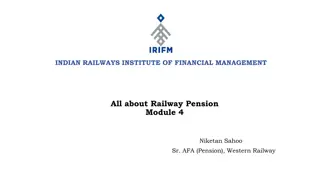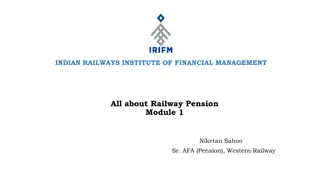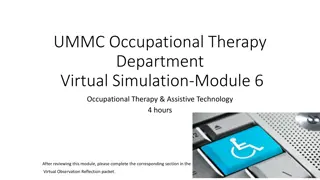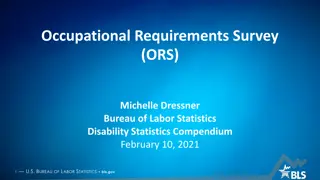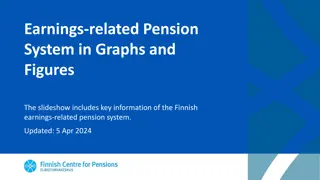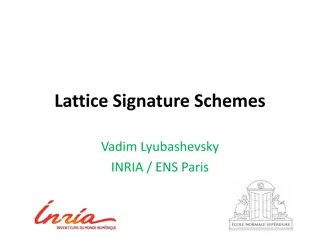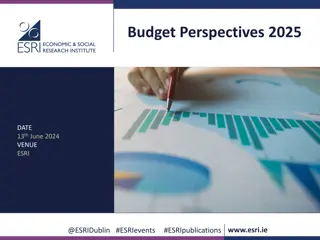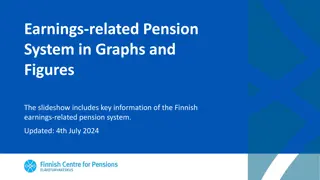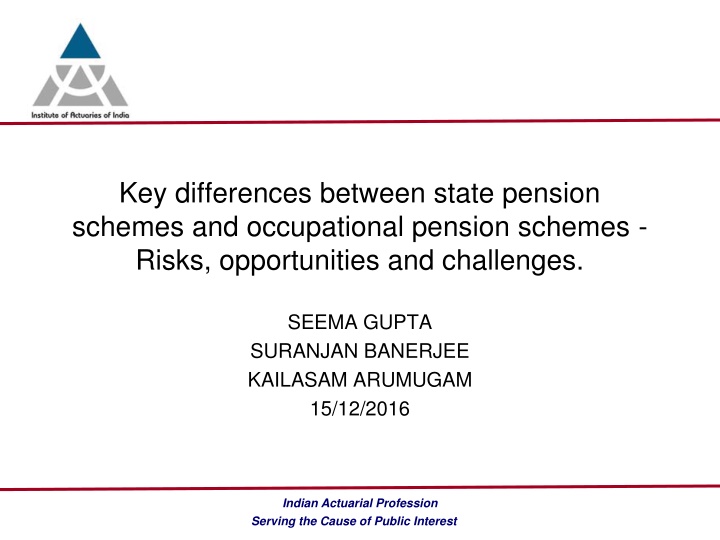
Key Differences Between State Pension Schemes and Occupational Pension Schemes: Risks, Opportunities, and Challenges
Explore the contrasting features of state pension schemes and occupational pension schemes in this insightful analysis, focusing on risks, opportunities, and challenges. Delve into the Indian pension landscape, examining the three pillars of pension provision, risks related to current structures, and potential opportunities for improvement. Stay informed about the evolving pension sector and its impact on retirement planning.
Download Presentation

Please find below an Image/Link to download the presentation.
The content on the website is provided AS IS for your information and personal use only. It may not be sold, licensed, or shared on other websites without obtaining consent from the author. If you encounter any issues during the download, it is possible that the publisher has removed the file from their server.
You are allowed to download the files provided on this website for personal or commercial use, subject to the condition that they are used lawfully. All files are the property of their respective owners.
The content on the website is provided AS IS for your information and personal use only. It may not be sold, licensed, or shared on other websites without obtaining consent from the author.
E N D
Presentation Transcript
Key differences between state pension schemes and occupational pension schemes - Risks, opportunities and challenges. SEEMA GUPTA SURANJAN BANERJEE KAILASAM ARUMUGAM 15/12/2016 Indian Actuarial Profession Serving the Cause of Public Interest
Agenda 1. Introduction to the Indian environment 2. The 3 pillars for pension provision 3. A comparison of state sponsored and other occupational arrangements 4. Risks associated with current structures 5. Some opportunities and challenges 6. Questions www.actuariesindia.org 2
1. Introduction to the Indian environment Gradual collapse in traditional old age support mechanisms Skewed coverage of existing benefit schemes Growth of informal workforce Need to increase domestic rate of savings www.actuariesindia.org 3
1. Introduction to the Indian environment (contd.) Worsening of financial position of unfunded state pensions arrangements Shift from DB to DC e.g. NPS Little flexibility within different DC arrangements Under developed private annuity market www.actuariesindia.org 4
2. The 3 pillars for pension provision Pillar I Pillar II Pillar III State Pensions Compulsory Non - contributory Occupational Pensions Compulsory Contributory* Private Pensions Voluntary Contributory * Public sector DB schemes contributory to the extent that no EPF contributions are made by the Government www.actuariesindia.org 5
2. The 3 pillars for pension provision Pillar I Core pension provided by the state to all citizens Aimed at the lower end of the economic strata, therefore means tested Minimal pension benefit Several such social assistance and welfare programmes exist both at state and central level Enables income transfer to poorer workers Generally not very well administered at the moment www.actuariesindia.org 6
2. The 3 pillars for pension provision (contd.) Pillar II The most well established pillar owing to legislation on Gratuity and Provident Fund Mandatory savings programmes at employment level Covers public and private sector employees Public sector employees were entitled to a final salary style DB pension e.g. Central Services Civil Pension New public sector employees now set up under a DC style arrangement National Pension Scheme (NPS) Private sector employees via compulsory programmes e.g. Employees Provident Fund www.actuariesindia.org 7
2. The 3 pillars for pension provision (contd.) Pillar III This pillar includes all kinds of voluntary savings Important pillar for the self employed or members of the informal workforce Achieved via a contribution to pooled funds with low investment risk such as Public Provident Fund (PPF) Or via personal savings vehicles geared towards retirement savings e.g. DC pension plans run by life insurance companies such as LIC Government has also opened up the NPS for individuals Incentives are usually provided by tax breaks (up to a certain limit) www.actuariesindia.org 8
3. A comparison of state sponsored and other occupational arrangements Next few slides set out a comparison between a typical state sponsored Pension Schemes (Pillar I) and Occupational Pension Schemes (Pillar II) through the following points: Objective of providing the Scheme Eligibility Scheme Design Funding Risk www.actuariesindia.org 9
3. A comparison of state sponsored and other occupational arrangements (contd.) Objectives State Sponsored Schemes Occupational Schemes Main objective - A welfare State Remove Poverty Social Security for old age Political & Economical Reasons Paternalism Compulsion/ Encouragement from State Competition Attract & Retain work force www.actuariesindia.org 10
3. A comparison of state sponsored and other occupational arrangements (contd.) Eligibility State Sponsored Schemes Occupational Schemes May cover all citizens Eligibility conditions vary by Company/Industry Or only BPL families Normally a minimum service is required Or some Target Population www.actuariesindia.org 11
3. A comparison of state sponsored and other occupational arrangements (contd.) Scheme design Retirement age usually 60 (prescribed by Government) Retirement age could vary by company and industry Normally a fixed benefit DB style benefit Depends upon Salary/Service/both DC style benefit where actual benefit not determined in advance www.actuariesindia.org 12
3. A comparison of state sponsored and other occupational arrangements (contd.) Scheme design (2) No refund of contribution Accumulated funds can be used as cash at retirement - DC Benefits only at a pre- determined age No option to the beneficiaries Options available to beneficiaries Commutation, Early Retirement, Annuity Option (DC Funds ) Inflation protection Inflation protection vary from scheme to scheme www.actuariesindia.org 13
3. A comparison of state sponsored and other occupational arrangements (contd.) Funding Pay as you go (PAYG) arrangement backed by government Generally through advance funding Regular funding Tax, Accounting Standards, Clean Balance Sheet No funds set aside / ring fenced Current tax payers contribute for current pensioners Contribution from Employers or Employees or both DC Schemes www.actuariesindia.org 14
3. A comparison of state sponsored and other occupational arrangements (contd.) Risks Theoretically, risk is retained by government Risks are shared by Employer In reality, adverse experience likely to impact future generations higher taxes, lower benefits, longer working lives Employee Insurance Companies Investment Banks www.actuariesindia.org 15
4.Risks associated with current structures Macro-economic shocks Demographic shocks Political risks Managerial risks Investment risks Market risks Longevity risks Disability risks www.actuariesindia.org 16
4. Risks associated with current structures Macroeconomic shocks Volatile inflation CPI has fluctuated between 3.5% and 6.0% over the last 20 months www.actuariesindia.org 17
4. Risks associated with current structures Demographic shocks Population covered under formal pension schemes in India Total Population 2015 2030 1282 m 1476 m 2050 1620 m Working Age Population 806 m 944 m 1007 m 60+ Population 297 m 112 m 181 m Source: CRISIL Insight January 2015. www.actuariesindia.org 18
4. Risks associated with current structures Demographic shocks Population covered under formal pension schemes in India 60+ Population 2015 2030 112 m 181 m 2050 297 m Government Pension Cover 35 m 68 m 92 m Private Pension Cover 4.8 m 63 m 122 m Uncovered Population 72 m 50 m 83 m www.actuariesindia.org 19
4. Risks associated with current structures Political risks Government may intervene to limit investment options and returns Continuous adherence to investment pattern Greater pressure on liquidity as well as returns Responsibility attached to the trustees Accounting standards Adherence to Professional Guidelines & Standards www.actuariesindia.org 20
4.Risks associated with current structures Managerial risks Incompetent and Fraudulent behavior of manager Good management practices require established and documented chains of reporting and responsibility Those with responsibility should have suitable qualifications and experience www.actuariesindia.org 21
4. Risks associated with current structures- Investment risks 10 year nominal bond index has fallen to 6.2% (6 December) from 7.7% at the start of the year Source: Bloomberg www.actuariesindia.org 22
4.Risks associated with current structures- Market risks Market risk is the risk relating to changes in the value of the portfolio due to movements in the market value of the assets In a defined contribution scheme, even the returns on safe assets such as long-term Government bonds vary substantially depending upon whether the interest rates were low or high at the time of retirement. Lower interest rates lead to lower annuities during the lifetime of the pensioner. The problem is further compounded by the fact that the annuity markets are thin in most countries. www.actuariesindia.org 23
4. Risks associated with current structures- Longevity risks Life expectancy (at birth) in India has increased by c10 years since 1990 Source: World Bank It is estimated to increase by a further c5 years 2050 www.actuariesindia.org 24
5. Opportunities and challenges Opportunity: Strengthen Pillar I by providing a single means tested pension, inflation linked sponsored by the state Challenges: Will be hard to implement as large number of population not engaged in organised sector Difficult to determine true cost and financial implications due to uncertainty with financial and demographic parameters Possible outcome: Consolidate the current arrangements and set up a ring fenced self sustaining fund which does not rely on generation dependency for contributions www.actuariesindia.org 25
5. Opportunities and challenges (contd.) Opportunity: Carefully review the public and private DB pension liabilities and ensure better governance framework exists to manage key risks Consider private placement of some of the risks involved e.g. longevity Challenges: Quantification of risks will be hard due to difficulties in setting parameters for estimating liabilities Complying with accounting standards for financial reporting (private sector) Political risks as the government may not have an appetite to engage (public sector) www.actuariesindia.org 26
5. Opportunities and challenges (contd.) Possible outcomes: Engage with actuarial advice and attempt to determine the funds needed for existing DB promise and how cashflows are likely to develop Use of sophisticated ALM techniques to demonstrate benefits of risk transfer / management Use these to assist funded arrangements to hold more return seeking assets with de-risking triggers or LDI Consider scenarios with stresses on bond yields, inflation and other parameters Engage with actuarial advice with adherence to professional guidelines and standards required by the professional body www.actuariesindia.org 27
5. Opportunities and challenges (contd.) Opportunity: Provide further incentives for investments geared towards retirement and allow portability between different DC funds (e.g. EPF and NPS) Increase coverage for informal sector, particularly self employed Challenge: Lack of awareness, particularly about effects of inflation Reluctance to move out of default state often not the ideal option Possible outcomes: Provide more education to individuals via their employers and enable technology to deal with large volumes Some form of compulsory provision for self employed www.actuariesindia.org 28
6. Questions www.actuariesindia.org 29
References 1. Goswami, Ranadev (2001), Indian Pension System: Problems and Prognosis, Indian Institute of Management, Bangalore Ernst and Young LLP and CII (2013), Pensions Business in India KPMG and FICCI (2015), Employee Pensions in India: current practices, challenges and prospects Allianz (2013), What s happening in India: Pension and Retirement Update United Nations (2013), World Population Prospects the 2012 Revision Bhattacharya, B.K. (2003), Report of the Group to Study the Pension Liabilities of the State Governments, Reserve Bank of India Willmore, Larry (2000), Three Pillars of Pensions? A Proposal to End Mandatory Contributions, United Nations 2. 3. 4. 5. 6. 7. www.actuariesindia.org 30



